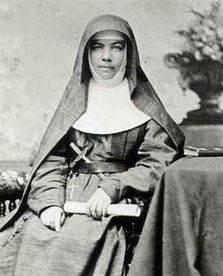
Fr Woods had been very concerned about the lack of education and particularly Catholic education in South Australia. In 1866, he invited MacKillop and her sisters Annie and Lexie to come to Penola and to open a Catholic school.[8] Woods was appointed director of education and became the founder, along with MacKillop, of a school they opened in a stable there. After renovations by their brother, the MacKillops started teaching more than 50 children. At this time Mary made a declaration of her dedication to God and began wearing black.
On 21 November 1866, the feast day of the Presentation of Mary, several other women joined Mary and her sisters. Mary adopted the religious name of Sister Mary of the Cross and she and Lexie began wearing simple religious habits. The small group began to call themselves the Sisters of St Joseph of the Sacred Heart[8] and moved to a new house in Grote Street, Adelaide. There they founded a new school at the request of the bishop, Laurence Bonaventure Sheil OFM. Dedicated to the education of the children of the poor, it was the first religious institute to be founded by an Australian.
MacKillop founded a convent and base for the Sisters of St Joseph in Petersburg on 16 January 1897. "On January 16th, 1897, the founder of the Sisters of St Joseph of the Sacred Heart, Mother Mary of the Cross,[19] arrived in Petersburg to take over the school. She was accompanied by Sister Benizi (who was placed in charge of the school), Sister M. Joseph, Sister Clotilde and Sister Aloysius Joseph. They were met at the station by Rev. Father Norton who took them to the newly blessed convent, purchased for them on Railway Terrace."The property at 40 Railway Terrace is identified as the convent by a plaque placed by the Catholic diocese of Peterborough.
After the death of Mother Bernard, MacKillop was once more elected unopposed as superior general in 1899,a position she held until her own death. During the later years of her life she had many problems with her health which continued to deteriorate. She suffered from rheumatism and after a stroke in Auckland, New Zealand in 1902, became paralysed on her right side. For seven years, she had to rely on a wheelchair to move around, but her speech and mind were as good as ever and her letter writing had continued unabated after she learned to write with her left hand. Even after suffering the stroke, the Josephite nuns had enough confidence in her to re-elect her in 1905.
She died on 8 August 1909 in the Josephite convent in North Sydney. The Archbishop of Sydney, Cardinal Moran, stated that: "I consider this day to have assisted at the deathbed of a Saint." She was laid to rest at the Gore Hill cemetery, a few kilometres up the Pacific Highway from North Sydney.
After her burial, people continually took earth from around her grave. As a result, her remains were exhumed and transferred on 27 January 1914 to a vault before the altar of the Virgin Mary in the newly built memorial chapel in Mount Street, Sydney.
On 19 December 2009, the Congregation for the Causes of Saints issued a papal decree formally recognising a second miracle, the complete and permanent cure of Kathleen Evans of inoperable lung and secondary brain cancer in the 1990s. Her canonisation was announced on 19 February 2010 and subsequently took place on 17 October 2010. This made her the first Australian to be recognised as a saint by the Catholic Church.




